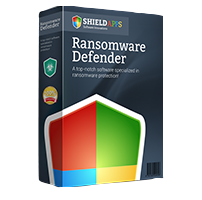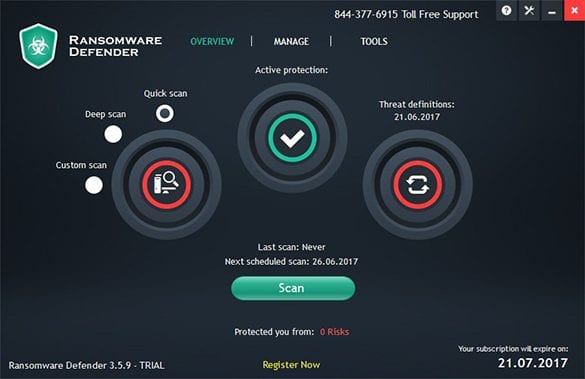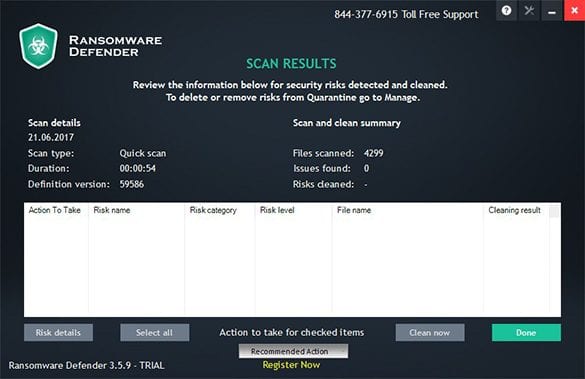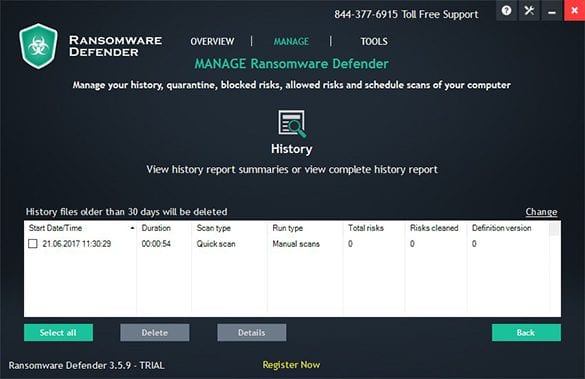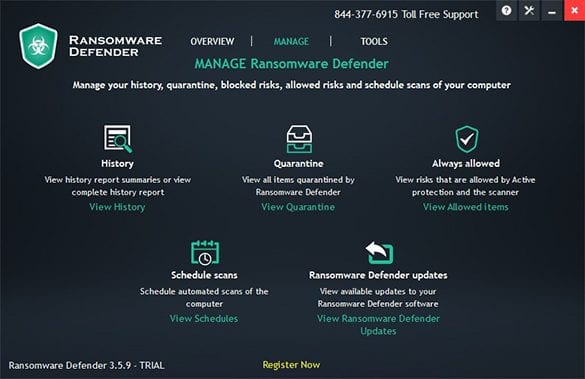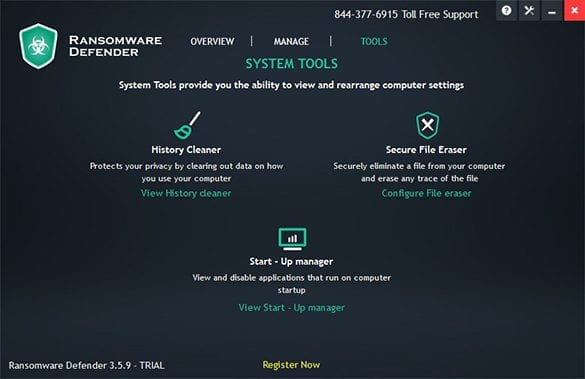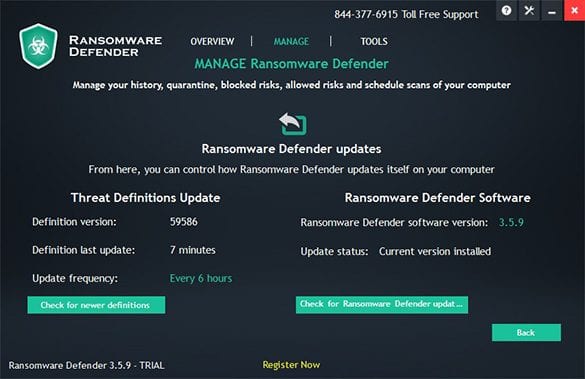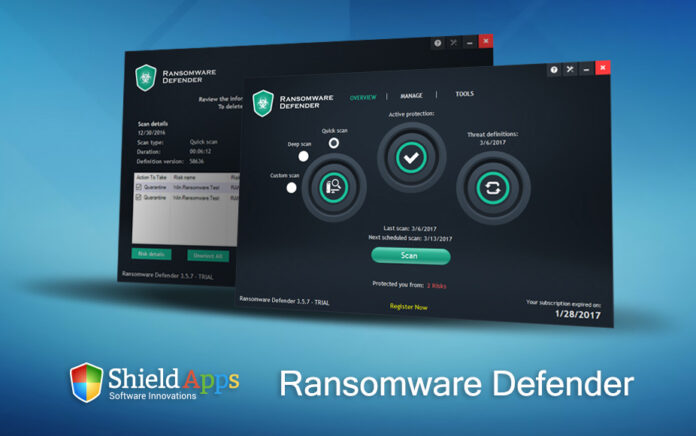
What is Ransomware Defender?
As the ransomware epidemic is going on a rampage, there is no computer completely immune to crypto-backed onslaughts. Victims – both home users and enterprises – get locked out of their important data and pressured into paying Bitcoins for decryption. Quite a few hallmark signs of the present-day ransom Trojans complicate regular detection. For instance, the malicious code may utilize exploits, abuse Remote Desktop Protocol or employ sophisticated obfuscation techniques to make the payload appear harmless. Some high-profile infections from this cluster even leverage a fileless contamination chain that allows them to fly under the radar of conventional defenses by injecting the malicious routine into legitimate Windows processes.
The Ransomware Defender application by ShieldApps was designed to fill the void between the increasingly complex attack tactics and inefficient detection mechanisms. Certified by AppEsteem, a reputable software evaluation company, it delivers active protection against file-encrypting malware as well as extensive options for on-demand scanning to accurately spot such perpetrating code. The utility easily identifies and blocks all catalogued and unique ransomware strains before they are able to do any damage. It also features flexible scan scheduling and automatic daily threat definitions updates to make the protection lasting and hassle-free. Furthermore, Ransomware Defender goes equipped with useful extras to protect privacy, fend off online threats, and optimize system start-up.
System Requirements
Screenshots
Usability
Installation of ShieldApps Ransomware Defender is a streamlined process that doesn’t require any special skills and takes a couple of minutes. You can opt for fully-functional 14-day trial period or register the product right away for $49.95. The first screen that pops up during the setup is about End User License Agreement acceptance, a standard one-click technicality. Once you agree, the “Installing Ransomware Defender” window will appear. This routine consists of 3 distinct phases: preparing the computer, installing software, and getting the latest definitions.
The application’s dark-gray GUI appears automatically right after the installation has been completed. It is clean and doesn’t include any redundant items. The main controls on the Overview pane are scan types, active protection, and threat definitions. The quick scan option is toggled on by default, so if you click the green Scan button at the bottom of the interface without changing any settings, Ransomware Defender will start checking the system paths most frequently hosting ransomware executables (AppData, LocalAppData, Program Files, ProgramData, and Windows).
Other scan modes include deep scan and custom scan. The former traverses the entire hard drive for ransomware traces, and the latter allows you to define specific folders to be checked. Be advised different scan types take different amounts of time to complete. In our case, the program ran quick scan for 1-2 minutes on average, whereas deep scan was a 28-30 minutes wait. You can view all previous reports on the History screen, but note that the logs are deleted in 30 days unless specified otherwise.
Another pane called Manage, which is available in the upper part of the GUI, provides the following controls: History (mentioned above), Quarantine, Always allowed, Schedule scans, and Ransomware Defender updates. Yet another tab called Tools includes additional privacy and optimization features: History Cleaner (clears temporary files as well as search and browser history), Secure File Eraser (wipes selected files with multiple overwrites to thwart forensic recovery), and Start-Up Manager (identifies processes launched at boot time and allows disabling unneeded ones).
By the way, ShieldApps Ransomware Defender gets automatically added to the start-up list after installation in order to protect the computer at all times. A noteworthy fact is that the product being reviewed can run alongside other antimalware suites, adding a supplementary counter-ransomware module to your security posture.
Features
When it comes to the feature set of a security solution, quantity and quality don’t necessarily cohere. Ransomware Defender goes with nothing more than the essentials that suffice to do the protection job right.
- Active protection is an intelligent feature that monitors your computer for various indicators of a ransomware attack in real time. Also, whenever you insert removable media such as a USB memory stick, the program displays a system tray popup with a recommendation to scan the device. If this module detects a potential threat, it stops the malicious activity in its tracks and notifies you of the incident.
- With extensive scanning options, you can get different areas of your machine checked for ransomware and other prevalent infections at any time. The default quick scan looks inside directories that are most likely to contain harmful executables, while deep scan covers the entirety of data stored on the local drives. Custom scan is self-explanatory, allowing you to check a specific data repository for indicators of compromise.
- Protection against online threats is a recent addition to the utility’s feature set. It complements the core anti-ransomware functionality with a module that identifies and blocks malicious websites in real time. This extra tier of defense also prevents deleterious online scripts from being executed on your machine.
- Automatic updates of threat definitions ensure that the program is capable of identifying all known ransomware and malware samples in the wild, including the most recent ones. The update frequency is set to every 6 hours by default, but you can define your custom timing via the Settings pane.
- With the scan scheduling feature at your disposal, you can specify the day of the week and the time to perform scans. This functionality also allows you select the type of scan for each scheduled action.
- ShieldApps Ransomware Defender provides logs of all previously completed scan instances. The time span that these summaries are kept is set to 30 days, but you can choose to keep all history or define a custom period.
- The Quarantine pane provides a list of all suspicious entities quarantined by the tool. With this feature in place, you can view, restore or delete such items in one click. Be advised that quarantined risks older than 30 days are automatically deleted.
- History Cleaner makes it easy to eliminate the following potentially fingerprintable information from your computer: cookies, Explorer MRUs (most recently used items), Internet cache, font cache, Windows search logs and temporary files, run history, and application temporary files.
- Secure File Eraser deletes selected data entries beyond recovery. To be able to use this function, you need to enable the “Erase Files” option so that it’s added to Windows Explorer context menu.
- Start-Up Manager provides a list of applications automatically triggered when Windows is launched. It’s easy to deselect any redundant entry and click the “Apply” button to make the changes take effect.
Efficiency
The product under scrutiny boasts a higher ransomware detection rate than most of the popular antivirus and antimalware suites that don’t focus specifically on combatting file-encrypting threats alone. The narrow specialty of ShieldApps Ransomware Defender certainly plays into users’ hands as its architecture aligns with the relevant knowledgebase on the particular modus operandi of ransomware threats. The tool intelligently prioritizes areas to monitor so that a crypto intruder is spotted and eradicated before it gets down to encrypting your personal data. Frequent definition updates keep the program highly reactive to the latest ransomware strains, and its heuristics won’t fail to identify emerging menaces that aren’t catalogued yet.
Help & Support
Product support is at your fingertips as the GUI of Ransomware Defender contains the appropriate Help icon in its upper right-hand corner. It leads to a dedicated web page covering frequently asked questions. A little nuance we noticed is that although the page says you can send a query via a form below the FAQs, this form is nowhere to be found there. So it takes some browsing the vendor’s site to actually submit your issue to support agents. Aside from this channel of getting assistance, there used to be an option to reach ShieldApps representatives by dialing a toll free phone number indicated at the top of the main application pane. It looks like this channel has been removed in Ransomware Defender v4.2.0. The publisher does provide an email address on its site for general questions and support.
+/- (Pros/Cons)
- High ransomware detection rate
- Protection against online threats added
- Extensive scan options
- Scan scheduling
- Intuitive GUI
- Runs alongside main AV or antimalware
- Privacy extras included
- Somewhat scarce self-help options
- GUI hasn’t been refreshed for quite some time
Bottom line
ShieldApps Ransomware Defender delivers a robust security barrier standing sentinel to protect a Windows computer against increasingly sophisticated file-encrypting threats. It is very easy to use and boasts small footprint on system performance. Be advised, though, that it should be used in tandem with a regular antivirus or antimalware suite to ensure comprehensive protection from different angles.
